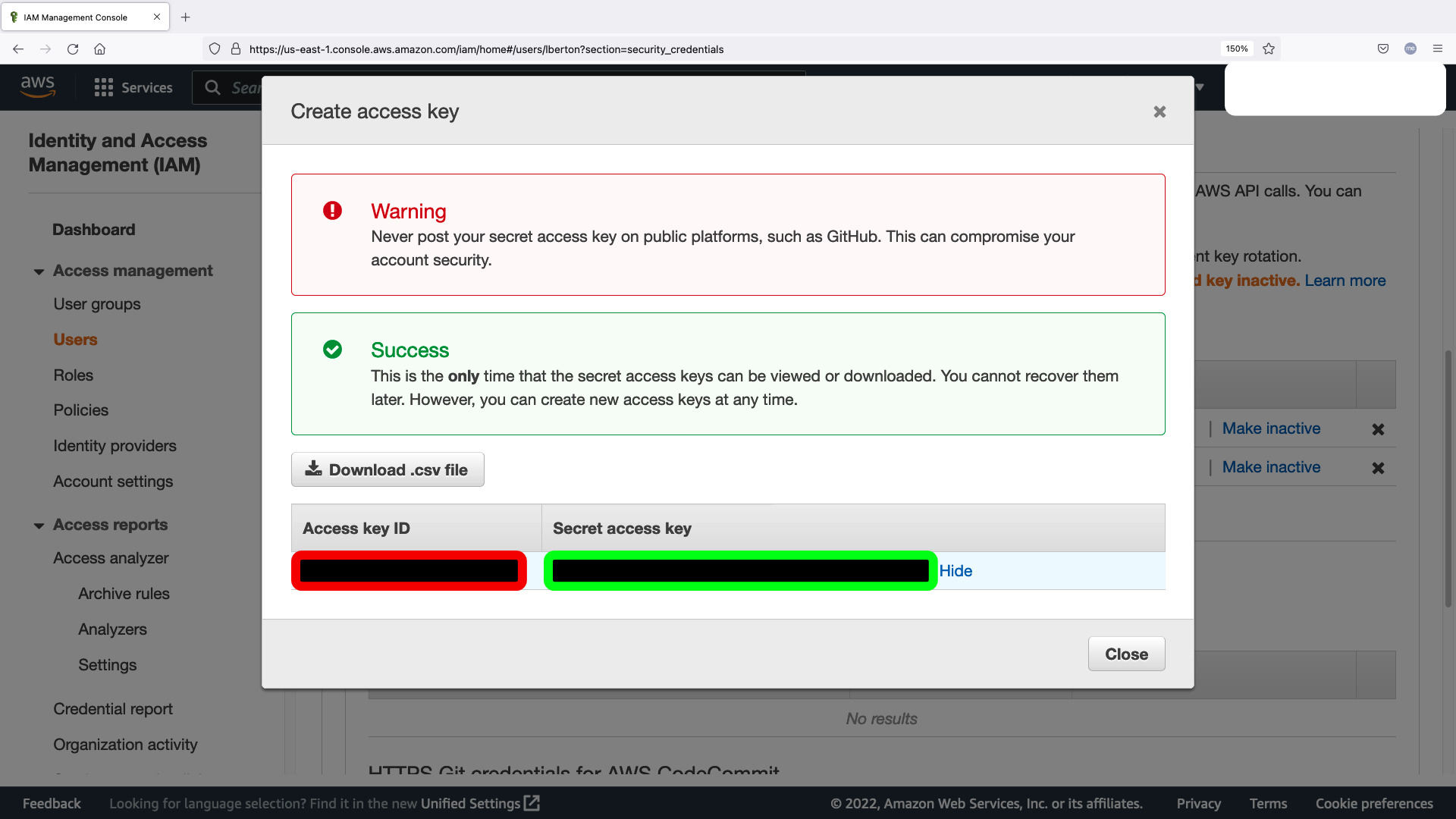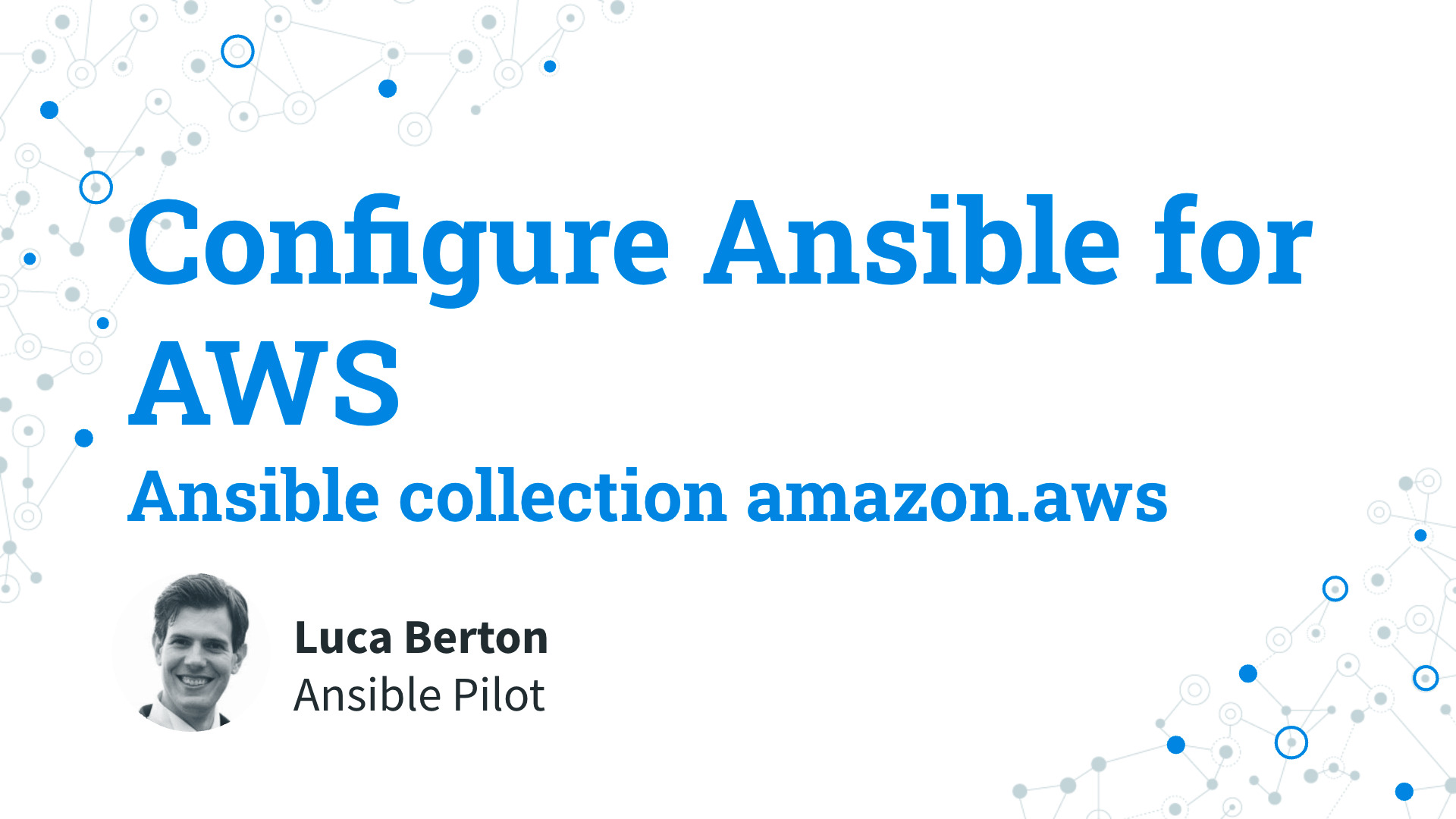How to configure Ansible for AWS?
Ansible provides various modules to manage AWS infrastructure, which includes EC2, VPC, Security Groups, etc.
I’ll show you step by step how to prepare your Ansible controller to interact with the AWS infrastructure.
This initial configuration sometimes is a roadblock for some AWS users to start using Ansible.
I’m Luca Berton and welcome to today’s episode of Ansible Pilot.
Configure Ansible for AWS
Amazon Identity and Access Management (IAM) Access Key
Python
boto3SDK requires 3.6+Ansible collection
amazon.aws
The Ansible modules and plugins support the AWS infrastructure interactions.
First of all, you need to authenticate using AWS Access Key credentials: Access Key ID and Secret Access Key from Identity and Access Management (IAM) dashboard.
Ansible AWS modules are written on top of boto3. boto3 is the Python SDK for the AWS that allows users to interact with AWS infrastructure via API.
This library interacts with the AWS API via the Ansible modules and plugins.
The boto3 Python library requires Python 3.6+.
The Ansible collection amazon.aws of modules and plugins manages various operations related to EC2, VPC, Security Groups, etc.
As the name suggests, this resource is provided by the Ansible Engineer Team.
Links

Playbook
Configure Ansible for AWS
- Amazon IAM Access Key
- Install Python boto3 SDK
- Install Ansible amazon.aws collection
- Ansible Playbook
How to Configure Ansible for AWS.
First of all, you need to install boto3 - the AWS API Python SDK.
Second, you need to install the Ansible amazon.aws collection.
Once everything is done on the node you could configure the Ansible Controller machine and run your first Ansible Playbook with the ec2_ami_info module to search for AMI in EC2 and verify the successful configuration.
Amazon Identity and Access Management (IAM) Access Key
Generate new “Access keys” credential in your Identity and Access Management (IAM) dashboard in your AWS infrastructure account. You should copy the Access key ID (red below) and Secret access key (green below) for the env.sh shell script.

- env.sh
Please substitute with your Access key ID (red below) and Secret access key (green below) from Amazon Identity and Access Management (IAM) Access Key.
#!/bin/bash
export AWS_ACCESS_KEY_ID="RED-CODE"
export AWS_SECRET_ACCESS_KEY="GREEN-CODE"
export AWS_DEFAULT_REGION="us-east-1"
Install Python boto3 SDK
This example uses Python 3.8 so pip3.8 tool, adapt to your current configuration.
[devops@demo aws]$ ansible --version
ansible [core 2.12.2]
config file = /etc/ansible/ansible.cfg
configured module search path = ['/home/devops/.ansible/plugins/modules', '/usr/share/ansible/plugins/modules']
ansible python module location = /usr/lib/python3.8/site-packages/ansible
ansible collection location = /home/devops/.ansible/collections:/usr/share/ansible/collections
executable location = /usr/bin/ansible
python version = 3.8.12 (default, Sep 16 2021, 10:46:05) [GCC 8.5.0 20210514 (Red Hat 8.5.0-3)]
jinja version = 2.10.3
libyaml = True
[devops@demo aws]$ sudo su
[root@demo aws]# pip3.8 install boto3
WARNING: Running pip install with root privileges is generally not a good idea. Try `pip3.8 install --user` instead.
Collecting boto3
Using cached https://files.pythonhosted.org/packages/21/b1/fafeff38043e4d4c18948109b96df295a7a11350fad32744aaa4e4917004/boto3-1.24.28-py3-none-any.whl
Collecting botocore<1.28.0,>=1.27.28
Using cached https://files.pythonhosted.org/packages/fa/9e/f7662cd2c326b74eee8bb91e2bf3ea61f2b2d62738863d53fe801dcfdeca/botocore-1.27.28-py3-none-any.whl
Requirement already satisfied: s3transfer<0.7.0,>=0.6.0 in /usr/local/lib/python3.8/site-packages (from boto3) (0.6.0)
Requirement already satisfied: jmespath<2.0.0,>=0.7.1 in /usr/local/lib/python3.8/site-packages (from boto3) (1.0.1)
Requirement already satisfied: urllib3<1.27,>=1.25.4 in /usr/local/lib/python3.8/site-packages (from botocore<1.28.0,>=1.27.28->boto3) (1.26.9)
Requirement already satisfied: python-dateutil<3.0.0,>=2.1 in /usr/local/lib/python3.8/site-packages (from botocore<1.28.0,>=1.27.28->boto3) (2.8.2)
Requirement already satisfied: six>=1.5 in /usr/lib/python3.8/site-packages (from python-dateutil<3.0.0,>=2.1->botocore<1.28.0,>=1.27.28->boto3) (1.12.0)
Installing collected packages: botocore, boto3
Successfully installed boto3-1.24.28 botocore-1.27.28
[root@demo aws]# pip3.8 list | grep boto
boto3 1.24.28
botocore 1.27.28
[root@demo aws]#
Install Ansible amazon.aws collection
[devops@demo aws]$ ansible-galaxy collection install --force amazon.aws
Starting galaxy collection install process
Process install dependency map
Starting collection install process
Downloading https://galaxy.ansible.com/download/amazon-aws-4.0.0.tar.gz to /home/devops/.ansible/tmp/ansible-local-62851lkitk3p/tmpapjfnzjm/amazon-aws-4.0.0-b69_h8xk
Installing 'amazon.aws:4.0.0' to '/home/devops/.ansible/collections/ansible_collections/amazon/aws'
amazon.aws:4.0.0 was installed successfully
[devops@demo aws]$ ansible-galaxy collection list amazon.aws
# /usr/lib/python3.8/site-packages/ansible_collections
Collection Version
---------- -------
amazon.aws 2.1.0
# /home/devops/.ansible/collections/ansible_collections
Collection Version
---------- -------
amazon.aws 4.0.0
[devops@demo aws]$
run Ansible Playbook
[devops@demo aws]$ source env.sh
[devops@demo aws]$ ansible-playbook ami_search.yml
[WARNING]: provided hosts list is empty, only localhost is available. Note that the implicit
localhost does not match 'all'
[WARNING]: Found variable using reserved name: name
PLAY [AMI search] *********************************************************************************
TASK [search for existing AMI] ********************************************************************
ok: [localhost]
TASK [debug] **************************************************************************************
ok: [localhost] => {
"ami_found": {
"changed": false,
"failed": false,
"images": [
{
"architecture": "x86_64",
"block_device_mappings": [
{
"device_name": "/dev/sda1",
"ebs": {
"delete_on_termination": true,
"encrypted": false,
"snapshot_id": "snap-03f2e24f30f580353",
"volume_size": 10,
"volume_type": "gp2"
}
}
],
"creation_date": "2020-11-02T11:01:38.000Z",
"deprecation_time": "2022-11-02T11:01:38.000Z",
"description": "Provided by Red Hat, Inc.",
"ena_support": true,
"hypervisor": "xen",
"image_id": "ami-096fda3c22c1c990a",
"image_location": "309956199498/RHEL-8.3.0_HVM-20201031-x86_64-0-Hourly2-GP2",
"image_type": "machine",
"name": "RHEL-8.3.0_HVM-20201031-x86_64-0-Hourly2-GP2",
"owner_id": "309956199498",
"platform_details": "Red Hat Enterprise Linux",
"public": true,
"root_device_name": "/dev/sda1",
"root_device_type": "ebs",
"sriov_net_support": "simple",
"state": "available",
"tags": {},
"usage_operation": "RunInstances:0010",
"virtualization_type": "hvm"
}
]
}
}
PLAY RECAP ****************************************************************************************
localhost : ok=2 changed=0 unreachable=0 failed=0 skipped=0 rescued=0 ignored=0
[devops@demo aws]$
Conclusion
Now you know Configure Ansible for AWS: Amazon IAM Access Key, boto3 Python library, amazon.aws collection and how to execute an Ansible Playbook using ec2_ami_info Ansible module.
Subscribe to the YouTube channel, Medium, and Website, X (formerly Twitter) to not miss the next episode of the Ansible Pilot.
Academy
Learn the Ansible automation technology with some real-life examples in my
Udemy 300+ Lessons Video Course.

My book Ansible By Examples: 200+ Automation Examples For Linux and Windows System Administrator and DevOps

Donate
Want to keep this project going? Please donate
